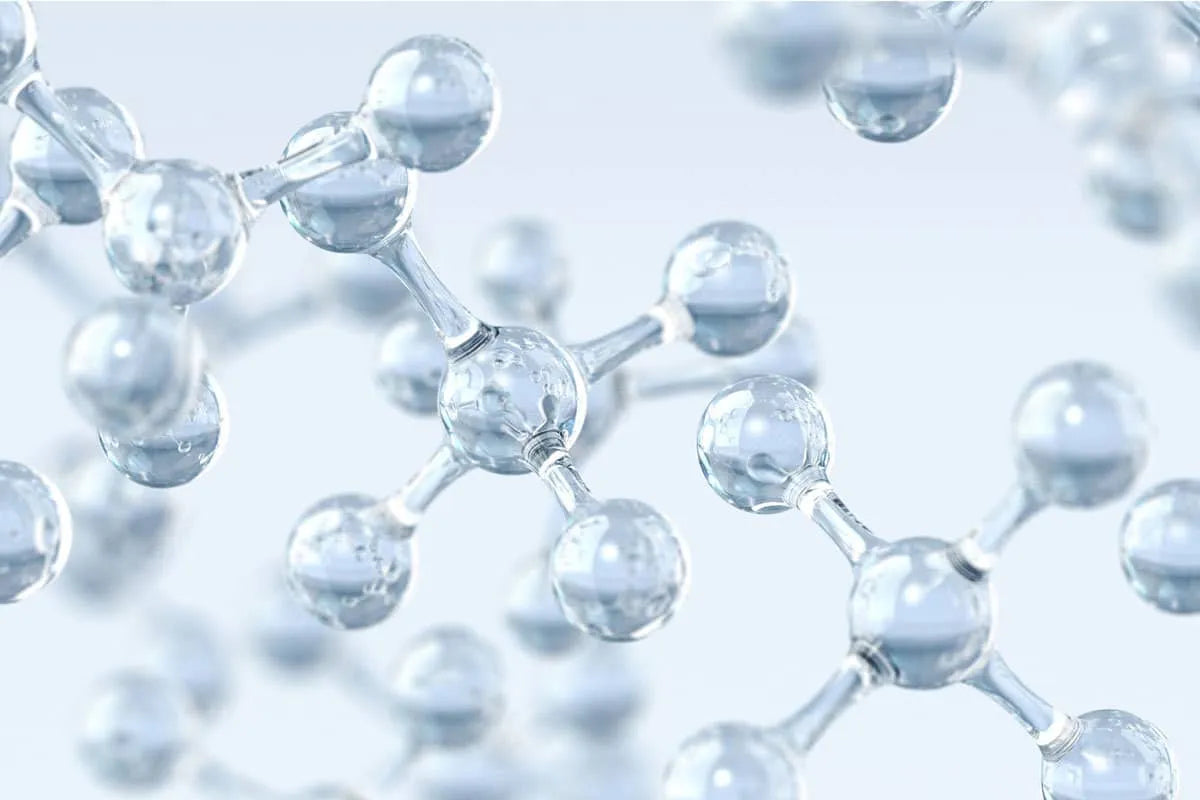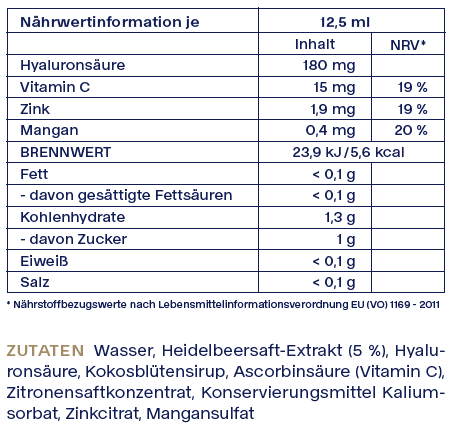Hyaluronic acid is a natural, endogenous substance that is mainly found in the joints and connective tissue. In combination with water, hyaluronic acid forms a viscous gel. This makes hyaluronic acid optimal in the body for water storage and as a lubricant.
Functions of hyaluronic acid in the body
Hyaluronic acid is an important component of the skin, mucous membranes, joint fluid, and the vitreous body of the eye. Learn everything here about the functions that hyaluronic acid fulfills in the human body.
Water storage
One gram of hyaluronic acid can bind up to six liters of water. This immense water storage capacity makes hyaluronic acid a universal helper throughout the body. It is found almost everywhere in the human organism, but about 50% is located in the skin and in the spaces between skin cells. There, it provides stability and elasticity by binding water. Interactions of hyaluronic acid with other substances enable the formation of a stable network from the various cell layers of the skin, the extracellular matrix, and the connective tissue. Hyaluronic acid also fulfills an important function in the vitreous body of the eye. The vitreous body is the large, central area of the eye that is transparent to light. It is filled with a mixture of 2% hyaluronic acid and 98% water. This mixture forms a viscous gel that is penetrated by collagen fibers. Here, hyaluronic acid ensures the elastic yet stable consistency of the vitreous body and its transparency.
Hyaluronic acid as a lubricant and shock absorber
Water is hardly compressible. Physicists and technicians take advantage of this poor compressibility of liquids in shock absorbers and hydraulic systems. It is similar in the human body. In connective tissue, hyaluronic acid causes water to be bound, simultaneously providing protection against shock and pressure. In the gelatinous core of the intervertebral discs, a hyaluronic acid gel absorbs the occurring pressure forces. Due to their viscous consistency, hyaluronic acid-containing gels also act as lubricants. In joints, the gel adheres to the articular cartilage and forms a slippery layer. One special feature makes hyaluronic acid particularly important in joints: the gel changes with the forces applied. It becomes more fluid the stronger the forces are. This property is called structural viscosity. The knee joint is optimally cushioned under strong pressure forces that act when standing or jumping off, because the joint fluid acts as a shock absorber. During movement, the lubricating function comes to the fore, reducing joint wear. During rapid shear movements of the joint – for example, in the knee joint while running – the synovia (joint fluid) liquefies and friction in the joint decreases.
Formation of proteoglycans
The tasks described so far relate to freely available hyaluronic acid. Further functions of hyaluronic acid are connected to its involvement in the formation of large molecules in the body, called proteoglycans. These are molecules where polysaccharides (glycans) are bound to a protein backbone. An important proteoglycan is aggrecan, which is a component of hyaline cartilage. This type of cartilage is found wherever high pressure loads occur, such as on most joint surfaces. Thus, hyaluronic acid not only protects the joints in the joint fluid but also in the form of proteoglycans within the joint cartilage.
Use of Hyaluronic Acid in Medicine
For medical use, sodium hyaluronate, the sodium salt of hyaluronic acid, is mostly used. It was previously obtained from rooster combs but is now mostly produced biotechnologically. Hyaluronic acid is used in various fields of human medicine.
Hyaluronic Acid for the Joints
In cases of osteoarthritis and joint wear, a preparation with hyaluronic acid can be injected directly into the joint. There, it increases lubrication and simultaneously acts as a shock absorber. Additionally, the hyaluronic acid forms a thin layer over the joint cartilage, protecting it from damage caused by inflammatory molecules. Depending on the preparation, between one and five injections may be necessary, usually administered weekly. Hyaluronic acid injections are especially common for knee osteoarthritis. However, they can also be used for osteoarthritis in the hip joint or for the regeneration of various joints after injuries. Statutory health insurance does not cover the costs, as the effectiveness has been assessed very differently in studies. Another option is the oral administration of hyaluronic acid in the form of dietary supplements. The hyaluronic acid then reaches the site of action via the bloodstream. While injections achieve higher concentrations of hyaluronic acid in the joint, oral intake is painless and does not damage the joint capsule through injections.
Use of Hyaluronic Acid on the Eye
For dry eyes, aqueous-based eye drops often only provide short-term relief. It is different when they contain hyaluronic acid. Hyaluronic acid ensures long-lasting moisture for the eye and a stable tear film. Eye ointments also adhere longer to the eye but often initially impair vision after application. Hyaluronic acid eye drops, however, do not affect vision. Hyaluronic acid is also frequently found in contact lens cleaning solutions. Additionally, some nasal sprays or throat lozenges contain hyaluronic acid to protect and moisturize the mucous membranes. Hyaluronic acid is also used by ophthalmologists and in specialized eye clinics. In surgical procedures on the eye, such as cataract surgery, hyaluronic acid solutions can fill the vitreous body or stabilize the anterior chamber of the eye.
Other medical applications of hyaluronic acid
New areas are continually being discovered where hyaluronic acid has medical benefits. In certain forms of incontinence, hyaluronic acid is successfully injected around the urethra. This treatment is mainly used for stress incontinence. During physical exertion such as lifting heavy objects, as well as sneezing or coughing, stress incontinence causes involuntary urine leakage. The so-called implantation therapy leads to a padding of the tissue around the urethra by injecting four depots of hyaluronic acid gel with a syringe. Another application of hyaluronic acid is vesicoureteral reflux in children. This involves the backflow of urine from the bladder into the renal pelvis. Stabilized hyaluronic acid can be injected into the ureter via endoscopy. This resolves the reflux in 50 to 90% of patients.
Use of hyaluronic acid in aesthetic medicine
In cosmetic surgery, hyaluronic acid has long been used to inject wrinkles and to plump or shape lips and other facial or body areas.
Injection of wrinkles
In aesthetic medicine, hyaluronic acid is most commonly used to fill wrinkles. Typical areas of application are worry lines (on the forehead), the frown line (between the eyebrows), or the nasolabial fold (running from the side of the nose toward the corner of the mouth). But other areas of use are also possible, including the neck, décolleté, or back of the hands. The injected hyaluronic acid not only plumps up the wrinkles and skin tissue but also activates skin regeneration by stimulating fibroblasts (cells in the connective tissue).
Tightening, shaping, and volume enhancement
When the elasticity and firmness of the skin decrease over time due to natural aging or influences such as UV rays, certain areas of the face often appear sunken. A gel made from stabilized hyaluronic acid can make facial contours firmer again and positively change the profile. An injection with hyaluronic acid can also be useful in other areas where volume needs to be restored. Lips that are too narrow or too loose can be reshaped. Even a correction of the nose is possible with hyaluronic acid without surgery if only minor asymmetries are present. In a similar way, breast augmentation can also be performed. Compared to surgery and the use of implants, such a significant enlargement is not possible. However, to balance differently sized breasts or to build up a bit more volume and firmness, a hyaluronic acid gel injected between the mammary gland and chest muscle is suitable.
Treatment of dents and scars
Scars or dents can often be distressing, especially when they are on the face. By injecting hyaluronic acid gels, dents can be plumped up and scars concealed. The method is suitable, for example, for acne scars or scars caused by surgeries or injuries. Unevenness in the skin surface after liposuction can also be evened out with hyaluronic acid.
Use of hyaluronic acid in cosmetics
Hyaluronic acid is ubiquitous in cosmetic advertising. Numerous eye gels, day, night, or anti-wrinkle creams contain hyaluronic acid and are supposed to fight wrinkles and make the skin firmer. Learn here what benefits the external application of hyaluronic acid has and whether hyaluronic acid can even penetrate the deeper layers of the skin.
Effect of hyaluronic acid on the skin
Hyaluronic acid is a natural component of human skin. It binds water and, through its gel-forming properties, ensures that skin and connective tissue remain plump and cushioned. This natural function primarily has protective properties. The side effect is also: skin well supplied with hyaluronic acid is smoother and has fewer wrinkles. As we age, the body produces less and less hyaluronic acid. This causes the skin to become drier, more sensitive, or develop wrinkles. When hyaluronic acid is applied externally, it works in the skin just like the body's own substance. Those who do not want to have wrinkles injected can use a serum or cream with hyaluronic acid. The advantage is that the creams are relatively inexpensive and no painful injections are necessary. Many people already regularly use a skin cream, so applying it does not require additional effort.
Chemical structure of hyaluronic acid
Hyaluronic acid belongs to polysaccharides in its chemical structure. These are long-chain carbohydrate molecules in which many individual sugars (monosaccharides) are connected. Well-known polysaccharides include starch (amylose and amylopectin), cellulose, or glycogen, which serves to store glucose in the body. If a polysaccharide consists of only one single, repeating monosaccharide unit, it is called a homoglycan. In contrast, a heteroglycan is made up of at least two different monosaccharides. Hyaluronic acid belongs to the heteroglycans and can be classified in the group of glycosaminoglycans. It consists of two monosaccharides: glucuronic acid and N-acetylglucosamine. These two simple sugars combine to form a disaccharide. 250 to 50,000 of these disaccharides form a hyaluronic acid molecule. This long chain twists into a helix.


